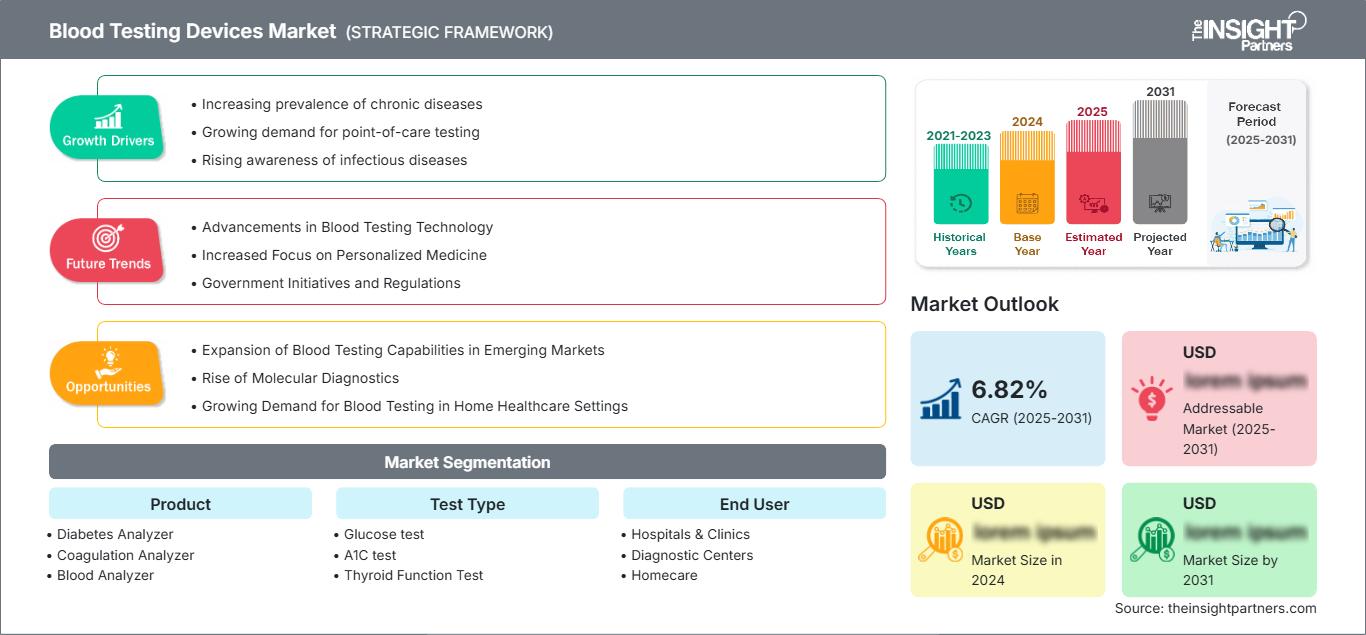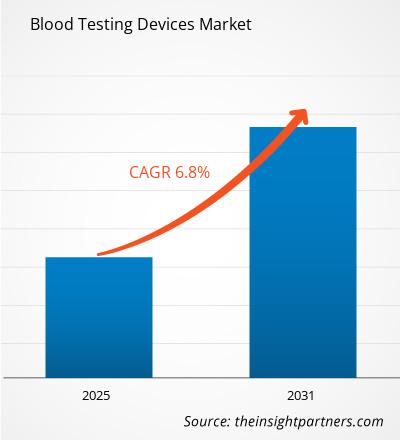Se espera que el tamaño del mercado de dispositivos para análisis de sangre alcance los 64.550 millones de dólares estadounidenses para 2031. Se anticipa que el mercado registre una CAGR del 8,7 % durante el período 2025-2031.
El informe está segmentado por producto (analizador de diabetes, analizador de coagulación, analizador de sangre y analizador de hematología), tipo de prueba (prueba de glucosa, prueba de A1C, prueba de función tiroidea, prueba de creatinina, prueba de coagulación, hemograma completo, prueba directa de LDL y otras) y usuario final (hospitales y clínicas, centros de diagnóstico y atención domiciliaria). El análisis global se desglosa a nivel regional y por país principal. El informe ofrece el valor en USD para el análisis y los segmentos mencionados.
Propósito del Informe
El informe "Mercado de Dispositivos para Análisis de Sangre" de The Insight Partners busca describir el panorama actual y el crecimiento futuro, los principales factores impulsores, los desafíos y las oportunidades. Esto proporcionará información a diversas partes interesadas del negocio, como:
- Proveedores/fabricantes de tecnología: Para comprender la dinámica cambiante del mercado y conocer las oportunidades potenciales de crecimiento, lo que les permitirá tomar decisiones estratégicas informadas.
- Inversores: Realizar un análisis exhaustivo de tendencias respecto a la tasa de crecimiento del mercado, las proyecciones financieras del mercado y las oportunidades que existen en toda la cadena de valor.
- Órganos reguladores: Regular las políticas y las actividades policiales en el mercado con el objetivo de minimizar el abuso, preservar la confianza de los inversores y defender la integridad y estabilidad del mercado.
Segmentación del mercado de dispositivos para análisis de sangre
- Analizador de diabetes
- Analizador de coagulación
- Analizador de sangre
- Analizador de hematología
Tipo de prueba
- Prueba de glucosa
- Prueba de A1C
- Prueba de función tiroidea
- Prueba de creatinina
- Prueba de coagulación
- Hemograma completo
- Prueba directa de LDL
- Otros
Usuario final
- Hospitales y clínicas
- Centros de diagnóstico
- Cuidado domiciliario
Geografía
- América del norte
- Europa
- Asia-Pacífico
- América del Sur y Central
- Oriente Medio y África
Obtendrá personalización en cualquier informe, sin cargo, incluidas partes de este informe o análisis a nivel de país, paquete de datos de Excel, así como también grandes ofertas y descuentos para empresas emergentes y universidades.
Mercado de dispositivos para análisis de sangre: Perspectivas estratégicas

-
Obtenga las principales tendencias clave del mercado de este informe.Esta muestra GRATUITA incluirá análisis de datos, desde tendencias del mercado hasta estimaciones y pronósticos.
Factores que impulsan el crecimiento del mercado de dispositivos para análisis de sangre
- Prevalencia creciente de enfermedades crónicas: En los últimos 25 años, la incidencia de enfermedades crónicas ha aumentado a nivel mundial debido a los cambios en el estilo de vida, lo que se traduce en un aumento en el número de cirugías. Por ejemplo, el cáncer colorrectal es uno de los cánceres más comunes y letales que se desarrollan en individuos debido a la influencia combinada de factores genéticos y ambientales. Según la Organización Mundial de la Salud (OMS), el cáncer colorrectal fue identificado como el tercer cáncer más común y el segundo con mayor mortalidad, con aproximadamente 1.926.425 casos a nivel mundial en 2022. La prevalencia de enfermedades crónicas como la diabetes, el cáncer y las enfermedades cardiovasculares está aumentando a nivel mundial, lo que genera una creciente necesidad de pruebas diagnósticas.
-
Creciente demanda de pruebas en el punto de atención: los dispositivos de pruebas en el punto de atención (POCT) permiten a los médicos o proveedores de atención médica administrar pruebas en el paciente. Alcance del informe
Análisis regional del mercado de dispositivos para análisis de sangre
Los analistas de The Insight Partners han explicado detalladamente las tendencias regionales y los factores que influyen en el mercado de dispositivos para análisis de sangre durante el período de pronóstico. Esta sección también analiza los segmentos y la geografía del mercado de dispositivos para análisis de sangre en América del Norte, Europa, Asia Pacífico, Oriente Medio y África, y América del Sur y Central.
Alcance del informe de mercado de dispositivos para análisis de sangre
Por el usuario finalPor tipo de prueba- Prueba de glucosa
- Prueba de A1C
- Prueba de función tiroidea
- Prueba de creatinina
- Prueba de coagulación
- Hemograma completo
- Prueba directa de LDL
- Otros
- Hospitales y clínicas
- Centros de diagnóstico
- Cuidado domiciliario
- Reino Unido
- Alemania
- Francia
- Rusia
- Italia
- Resto de Europa
- Porcelana
- India
- Japón
- Australia
- Resto de Asia-Pacífico
- Brasil
- Argentina
- Resto de América del Sur y Central
- Sudáfrica
- Arabia Saudita
- Emiratos Árabes Unidos
- Resto de Oriente Medio y África
Atributo del informe Detalles Tamaño del mercado en 2024 XX mil millones de dólares estadounidenses Tamaño del mercado en 2031 US$ 64.55 mil millones CAGR global (2025-2031) 8,7% Datos históricos 2021-2023 Período de pronóstico 2025-2031 Segmentos cubiertos Por producto - Analizador de diabetes
- Analizador de coagulación
- Analizador de sangre
- Analizador de hematología
Regiones y países cubiertos América del norte - A NOSOTROS
- Canadá
- México
Líderes del mercado y perfiles de empresas clave - Abbott
- Laboratorios Bio-Rad Inc.
- F. Hoffmann-La Roche Ltd
- Siemens AG
- Trinidad Biotech Plc.
- BioMerieux SA
- Corporación Luminex
- Thermo Fisher Scientific, Inc.
- Getein Biotech, Inc.
Densidad de actores del mercado de dispositivos para análisis de sangre: comprensión de su impacto en la dinámica empresarial
El mercado de dispositivos para análisis de sangre está creciendo rápidamente, impulsado por la creciente demanda de los usuarios finales debido a factores como la evolución de las preferencias de los consumidores, los avances tecnológicos y un mayor conocimiento de los beneficios del producto. A medida que aumenta la demanda, las empresas amplían su oferta, innovan para satisfacer las necesidades de los consumidores y aprovechan las tendencias emergentes, lo que impulsa aún más el crecimiento del mercado.

- Obtenga una descripción general de los principales actores clave del mercado de dispositivos de análisis de sangre
- Análisis histórico (2 años), año base, pronóstico (7 años) con CAGR
- Análisis PEST y FODA
- Tamaño del mercado, valor/volumen: global, regional y nacional
- Industria y panorama competitivo
- Conjunto de datos de Excel
Informes recientes
Informes relacionados
Testimonios
Razón para comprar
- Toma de decisiones informada
- Comprensión de la dinámica del mercado
- Análisis competitivo
- Información sobre clientes
- Pronósticos del mercado
- Mitigación de riesgos
- Planificación estratégica
- Justificación de la inversión
- Identificación de mercados emergentes
- Mejora de las estrategias de marketing
- Impulso de la eficiencia operativa
- Alineación con las tendencias regulatorias






















 Obtenga una muestra gratuita para - Mercado de dispositivos para análisis de sangre
Obtenga una muestra gratuita para - Mercado de dispositivos para análisis de sangre